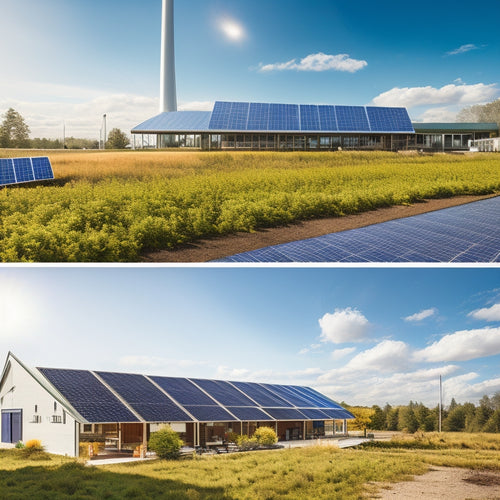Reflective Running in the Solar Age: Eco-Friendly Athletic Wear
Share
As you lace up for your next nighttime run, you're likely thinking about more than just your pace and route. With growing concerns about the environment, you're probably wondering how your athletic wear choices impact the planet. The good news is that reflective running gear has evolved to prioritize sustainability, combining high-performance visibility with eco-friendly materials. You'll want to know more about the innovative fabrics and initiatives that are changing the game for runners like you, and how your next purchase can make a difference.
Key Takeaways
• Sustainable materials like recycled polyester and organic cotton enhance performance while reducing waste and ecological footprint.
• Reflective gear, such as built-in strips, is crucial for visibility and safety during nighttime runs.
• Eco-friendly fabrics, including recycled polyester, organic cotton, and Tencel, provide superior moisture management and thermal regulation.
• Initiatives like polyester recycling, fabric scrap upcycling, and shoe recycling minimize waste and conserve natural resources.
• Luxury athletic wear brands prioritize the planet alongside profit, incorporating eco-friendly materials and closed-loop production systems.
Sustainable Materials for Performance
As you lace up your running shoes, consider the environmental impact of your gear, because the next generation of performance footwear is being crafted from sustainable materials that reduce waste and minimize ecological footprint. You're not just gearing up for a run, you're making a statement about your commitment to the planet.
Leading brands are now incorporating eco-friendly materials that not only reduce waste but also enhance performance.
For instance, recycled polyester and organic cotton are being used to create shoes that provide superior moisture management, keeping your feet dry and comfortable during even the most intense workouts. Thermal regulation is also a key benefit, ensuring that your feet stay cool in the summer and warm in the winter.
The result is a more efficient, high-performance running experience that's gentle on the environment. By choosing sustainable footwear, you're supporting a movement that prioritizes the health of our planet.
Visibility Matters at Nighttime
You're not just thinking about your environmental footprint when you choose sustainable footwear, you're also thinking about your safety, especially when running at night, which is why visibility matters.
Running in low-light conditions can be risky, and it's essential to take extra precautions to make sure you're seen by motorists and other road users. That's where reflective gear comes in - a game-changer for nighttime runners. Look for shoes, apparel, and accessories with built-in reflective strips or panels that bounce light back to oncoming traffic, making you more visible.
Safety features like these can make all the difference between a safe and enjoyable run, and a potentially hazardous one. By choosing reflective gear, you're not only reducing your environmental impact but also prioritizing your safety.
As you hit the roads at dawn or dusk, you can trust that you've got the right gear to keep you visible and safe. Stay seen, stay safe, and keep running with confidence.
Eco-Friendly Fabrics for Running
As you hit the pavement, you're not only concerned about your performance, but also the environmental impact of your gear.
You're probably wondering what eco-friendly fabric options are available to you. From sustainable materials to recycled polyester, you'll discover a range of innovative textiles that'll help reduce your carbon footprint with every step.
Sustainable Material Options
Choose eco-friendly fabrics that wick away sweat and keep you cool, while also reducing your carbon footprint, with sustainable material options like recycled polyester, organic cotton, and Tencel. These fabrics not only perform well during your runs but also help reduce the environmental impact of the fashion industry. As a conscious runner, you're likely aware of the importance of sustainable fashion practices, and choosing the right fabric is a great place to start.
| Fabric | Benefits |
|---|---|
| Recycled Polyester | Reduces waste in landfills, conserves non-renewable resources |
| Organic Cotton | Grown without toxic pesticides, reduces water pollution |
| Tencel | Made from wood pulp cellulose, biodegradable, and compostable |
Recycled Polyester Benefits
By opting for recycled polyester, you'll help divert millions of plastic bottles from landfills, where they'd otherwise take centuries to decompose. This eco-friendly fabric choice not only reduces waste but also decreases the need for virgin polyester production, which is a significant contributor to greenhouse gas emissions.
When you wear recycled polyester, you're supporting microplastic reduction efforts, as fewer plastic bottles end up in oceans and waterways. Additionally, many recycled polyester producers engage in carbon offsetting, further minimizing their environmental footprint.
As a runner, you're likely no stranger to pushing yourself to be better; now, you can extend that mindset to your gear. By choosing recycled polyester, you're making a powerful statement about the importance of environmental responsibility. You're not just running for personal bests; you're running for a cleaner, greener future.
Recycling and Upcycling Initiatives
You can greatly reduce your environmental footprint by adopting recycling and upcycling practices that transform discarded materials into innovative, eco-friendly products. By embracing closed-loop systems, you can guarantee that materials are constantly cycled back into production, minimizing waste and the continuous demand for new resources. Waste reduction strategies, such as upcycling, can also help to conserve natural resources and decrease landfill waste.
Here are some innovative recycling and upcycling initiatives:
| Initiative | Description |
|---|---|
| Polyester Recycling | Converts post-consumer polyester into new fabric |
| Fabric Scrap Upcycling | Transforms fabric scraps into accessories or new apparel |
| Shoe Recycling | Collects and recycles used shoes into new products |
| Textile Take-Back | Encourages consumers to return used clothing for recycling |
| Repurposed Materials | Uses recycled materials to create new athletic wear products |
Designer Brands Leading the Way
Leading the sustainable fashion revolution, eco-conscious designer brands are revolutionizing the industry with innovative recycling technologies and environmentally responsible production methods. You're witnessing a new era of luxury marketing, where high-end brands prioritize the planet alongside profit.
Luxury athletic wear brands, in particular, are taking a stand. They're partnering with brand ambassadors who embody the eco-friendly ethos, promoting sustainable living through their personal and professional lives.
These trailblazing brands are redefining the fashion landscape, incorporating eco-friendly materials, reducing waste, and implementing closed-loop production systems. By doing so, they're setting a new standard for the industry, encouraging competitors to follow suit.
As a result, you're seeing a surge in demand for eco-friendly athletic wear, with consumers increasingly expecting sustainable practices from their favorite brands. The luxury market is shifting, and you're at the forefront of this revolution. Get ready to experience the future of athletic wear, where style meets sustainability.
Running Towards a Greener Future
As you lace up your eco-friendly sneakers, every step you take on the pavement contributes to a greener future, where the rhythm of your footfalls echoes the beat of a sustainable tomorrow. You're not just running for your own fitness, but for the health of the planet. By choosing eco-friendly athletic wear, you're supporting brands that prioritize environmental advocacy. This means that with every step, you're promoting sustainable practices, reducing waste, and conserving resources.
| Sustainable Practices | Environmental Impact |
|---|---|
| Carbon offsetting | Reduces greenhouse gas emissions |
| Recycling materials | Conserves natural resources |
| Using eco-friendly dyes | Reduces water pollution |
| Implementing sustainable manufacturing | Decreases waste and energy consumption |
Frequently Asked Questions
Can I Wash My Eco-Friendly Athletic Wear With Regular Detergent?
When washing your eco-friendly athletic wear, you should opt for mild, eco-friendly detergent options to maintain their performance and longevity. Limit washing frequency to only when necessary to reduce environmental impact.
Are Reflective Materials Used in Eco-Friendly Running Clothes?
You opt for eco-friendly running clothes that incorporate reflective materials, ensuring nighttime safety while running. These innovative fabrics, made from sustainable materials, provide visibility and peace of mind, aligning with your commitment to the planet.
Do Eco-Friendly Fabrics Affect Running Performance Negatively?
You'll be relieved to know that eco-friendly fabrics won't hinder your running performance. In fact, they often feature advanced moisture management and lightweight fabric weights, ensuring you stay cool, dry, and powered throughout your run.
Can I Return or Exchange Eco-Friendly Athletic Wear if It's Defective?
You can rely on return policies and exchange guarantees from eco-friendly athletic wear brands, ensuring you're not stuck with defective gear, and can instead focus on crushing your sustainable fitness goals with confidence.
Are There Any Discounts for Buying Eco-Friendly Athletic Wear in Bulk?
You're in luck! Yes, you can score bulk discounts on eco-friendly athletic wear. Our wholesale options offer corporate sales and group rates for team orders, perfect for environmentally conscious teams and businesses.
Related Posts
-

How Solar Panels Increase Property Value
Installing solar panels considerably increases your property value by improving energy efficiency and attracting eco-...
-

High-Performance Solar Solutions for Sustainable Living
High-performance solar solutions are your gateway to sustainable living, maximizing energy efficiency while considera...
-

Off-Grid Solar Solutions for Eco-Conscious Businesses
Off-grid solar solutions offer you a path to both sustainability and substantial cost savings. By adopting these syst...


